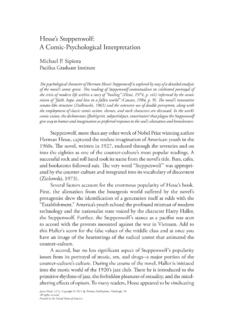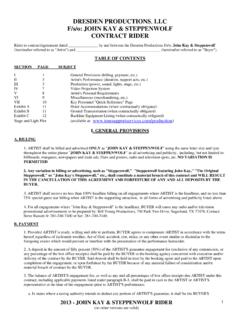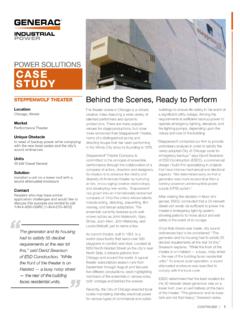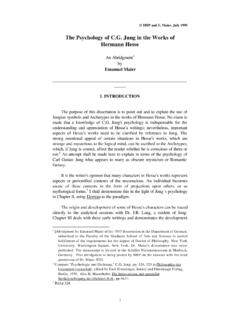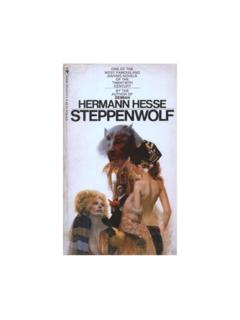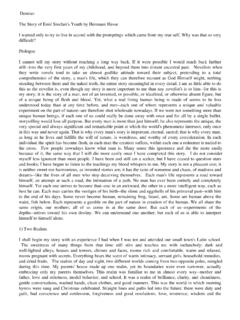Transcription of HOW STEPPENWOLF EXCELLED, FIRST ON THE BOARDS, …
1 HOW STEPPENWOLF EXCELLED, FIRST ON THE BOARDS, THEN IN THE BOARDROOM, AND ULTIMATELY ON THE BALANCE SHEETAn Unfinished Drama in at Least Three Acts, Probably MoreBY TONY PROSCIO AND CLARA MILLER with Alice Fisher, Jason Kuschner, and Wells ChenSpend a few hours touring the offices, stages, production facilities, and other real-estate holdings that are now the STEPPENWOLF Theater Company, and it can be hard to conjure the delinquent little outfit that a founder once described as subtle as Ex-Lax. In a warren of cubicles and workstations seemingly lifted from the Dilbert comic strip, with blinking spreadsheets and scrolling databases and network file servers whirring in every corner, a tattered poster from Sam Shepard s Buried Child or Lanford Wilson s Balm in Gilead may be the only reminder that this remains the home of what one drama critic called gangsta theater epicenter of a ferocious and combustive dramatic style and at the same time.
2 Of what may be the most revered acting ensemble in the United story of how a small troupe of undergraduates morphed into a national insti-tution is, at least in theater circles, already a matter of legend. The less-told tale (though scarcely less dramatic) is the one lurking behind the cubicles, spreadsheets, and servers: how a company of unpaid artists, armed with little more than borrowed props and greasepaint, funded mainly by box office receipts and a few small grants, transformed itself into a million-a-year enterprise with real estate and other assets approaching million and counting.
3 Nonprofit Finance FundRising in Stages Rising In Stages, p. 2 Nonprofit Finance Fund 70 West 36th Street Eleventh Floor New York, NY 10018 phone (212) 868-6710 fax (212) 268-8653 Copyright 2003, All rights reserved Nonprofit Finance FundIt is tempting, but usually wrong, to tell such stories in the arts as if they were triumphs solely of talent and vision, viewing a stable business and capital structure as simply the natural rewards of creative genius.
4 In reality, the vision, the business operations, and the capital form something like the walls of a pyramid; if any one moves or grows, the other two must change accordingly, or the whole structure comes apart. In that respect, STEPPENWOLF s spectacular artistic success is merely one-third of its history as a company. The other two-thirds are the subject of this consistent artistic excellence, maintained by a stable corps of actors, writers, and directors over the course of three decades, is unquestionably a crucial part of that growth, not just part of the story, but fundamental to everything that fol-lows.
5 For instance, unlike nearly every other successful American acting ensemble, STEPPENWOLF managed to preserve the loyalty and cohesion of its artistic troupe. Though the core ensemble now has members distributed across multiple time zones (it started with three, and quickly grew to nine, in a small corner of metro-politan Chicago), they have by now been the same people for many years. Most return to the theater regularly for performances, fundraisers, and creative refresh-ment. The governing artistic committee today consists of the same three actors who, not long out of high school, set out to change American theater, and continuity is what prevents this from being a kind of wistful then-and-now story.
6 It s more of a now-and-now story, a tale of lives lived in parallel: a business of increasing complexity and sophistication, with physical and financial assets that grew nearly as fast as its international reputation, alongside an ungovernable gang of artists that s still apt to issue obligatory rain coats to front-row audience mem-bers. Striking that balance among sound business operations, productive artistic pandemonium, and a capital structure that fully supports both has never been simple. Along the way, for at least a few years, it became perilously hard.
7 Few nonprofit institutions, especially in the arts, are truly secure. Even fewer are self-sufficient, if that means supported principally by earned revenue. But the best ones endure with some combination of donations, box office receipts, smart invest-ment, and consistent, FIRST -rate management and governance. But each of those things represents its own separate struggle. Losing any one of them can be the end of the now seems highly likely to be one of the successes. But that was not always so clear. And for a long time it was not clear at all.
8 In fact, for roughly two decades, as one of the founders put it, there was never any real agreement about Rising In Stages, p. 3 Nonprofit Finance Fund 70 West 36th Street Eleventh Floor New York, NY 10018 phone (212) 868-6710 fax (212) 268-8653 Copyright 2003, All rights reserved Nonprofit Finance Fundhow to run the place, ever. By the time STEPPENWOLF came up with such an agree-ment, it would already own a million theater, bring in annual income of more than million, and see its ensemble dispersed across the country and sometimes around the world.
9 How the principals kept the company together, aligned its assets to its artistic mis-sion, and found a secure, sustainable way to run the place is a story that begins, in a sense, the FIRST time the art and the business collided. 1974-1988: NOT JUST A BUNCH OF KIDS The FIRST time the STEPPENWOLF board of directors ever said No to an artistic idea, the company was already approaching its eighth birthday. By then STEPPENWOLF was well on its way to being the hottest phenomenon in American theater in a genera-tion, with a stream of hits in Chicago and a sold-out production in New York, miles from home.
10 (The play, Sam Shepard s True West, won two of Off-Broadway s Obie awards that year for its principals, Gary Sinise and John Malkovich.) Through most of those FIRST eight years, the board members main role apart from that of parent, neighbor, or fan had been to keep the lights on, raise or contribute enough to bridge the small gap between ticket receipts and production costs, and provide its ensemble of actors, writers, and directors with whatever resources the board could scrounge up. In its early years, says veteran member Bruce Sagan, the board consisted of the people who loaned them kitchen chairs.
